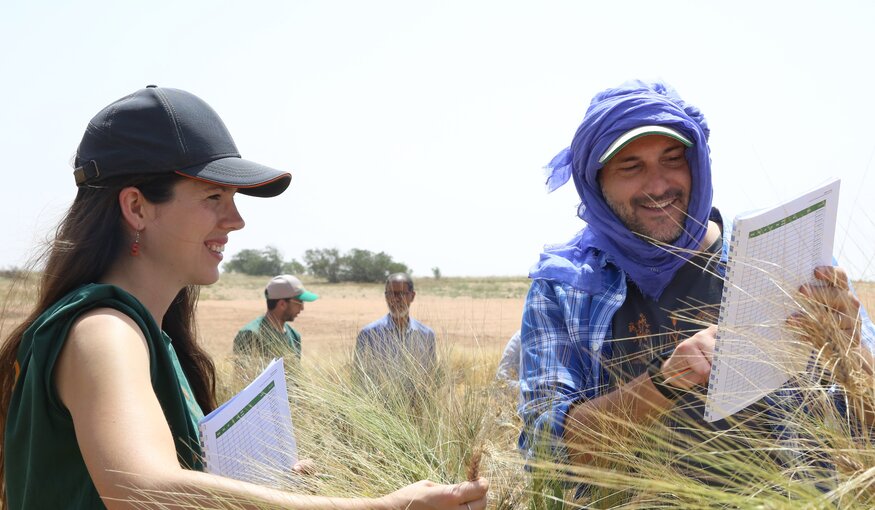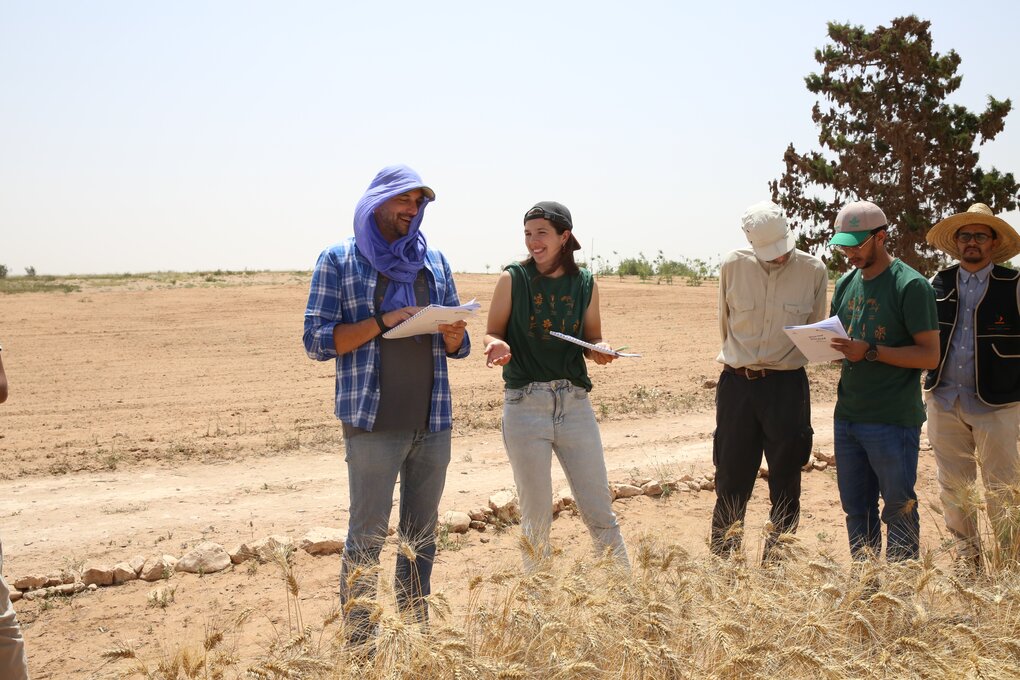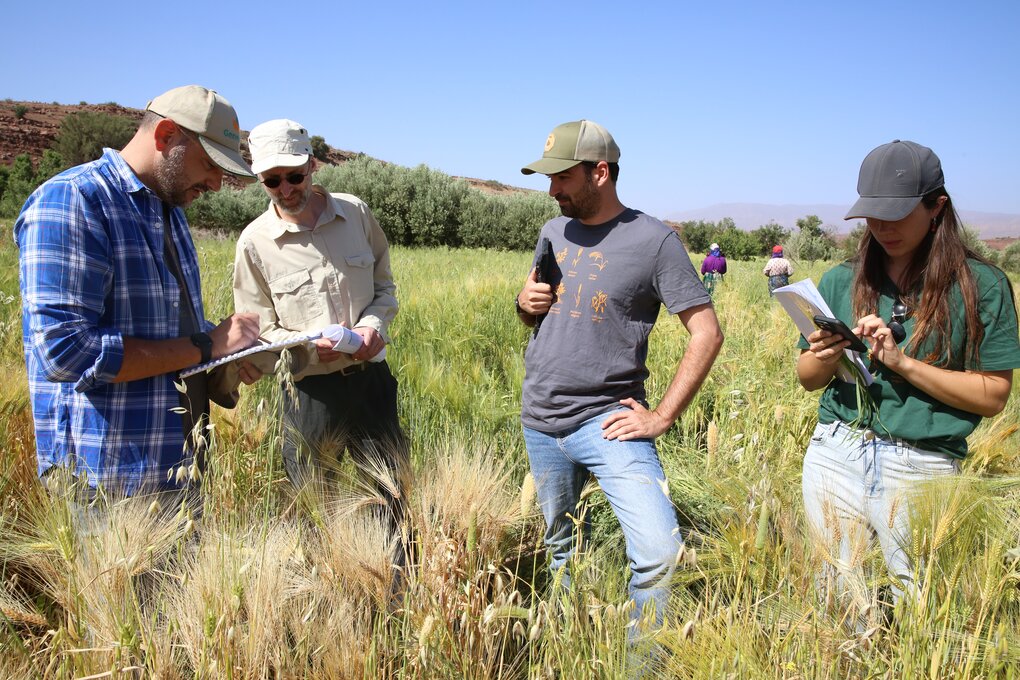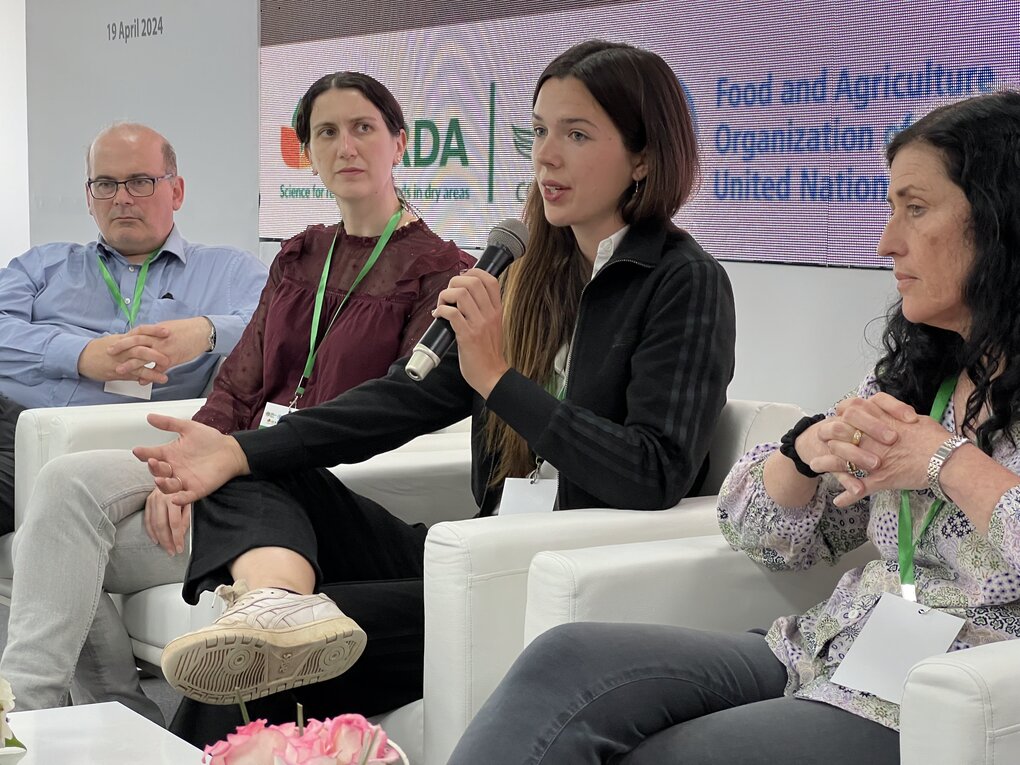July 23, 2024

It's April. Night is falling in Agadir, a coastal Moroccan city bordering the southern Atlantic coast, and Anna is talking about her pre-breeding work and the day's experiences, which included visiting farmers in an isolated rural location – a green and yellow oasis secluded in the middle of dry and parched, red-soiled hills – who are growing and evaluating BOLD-developed barley and durum wheat lines in their fields.
Anna Backhaus joined ICARDA (International Center for Agricultural Research in the Dry Areas) last year. She is a cereal pre-breeder, working with durum wheat and barley, two crops of global importance that, under the BOLD (Biodiversity for Opportunities, Livelihoods and Development) project, are getting an injection of traits that will make them more resilient to future climatic stresses.
"My job is to build a bridge between the genebank and the breeding programs. It's a dream position for me," she says.
As a pre-breeder, Anna dives into a genebank collection to identify the potentially promising diversity and then finds ways to evaluate and cross it into the breeding materials needed by durum wheat and barley breeders.
Indeed, pre-breeding positions are rare, but that might soon change.
"I think there will be an increasing need for pre-breeders, to maximize the use of genebanks – in how we use and access the diversity housed there."
 Anna (R) with Filippo Bassi, ICARDA's durum wheat breeder, compare notes as they evaluate pre-breeding material of durum wheat at INRA's Beni Mellal station.
Anna (R) with Filippo Bassi, ICARDA's durum wheat breeder, compare notes as they evaluate pre-breeding material of durum wheat at INRA's Beni Mellal station.
Crop Trust: What attracted you to this position at ICARDA?
Anna Backhaus: This idea that these hidden gems in the genebank can be used to fight future challenges related to climate change and farming, and improve livelihoods. We do scientific work that directly impacts farmers; that is something I'm extremely passionate about. But it's important for me to see how my work fits in with so many other moving pieces.
CT: Maybe that's why you are a pre-breeder, someone who is comfortable cohabitating in both the genebank and the breeding universes. The former conserves crop diversity; the latter uses it.
Anna: And I'm the bridge. I think you need a bridge when you have, for example, a social scientist and plant breeder – they will talk at each other but not really have the common language and common views. Sometimes you're so involved with your work that it's hard to fully understand or collaborate with others.
In a genebank, there are those who find new diversity and collect it. Breeders are focused on genetic gains. This takes a lot of time and it’s a costly process. For breeders not all diversity is good; like diversity for height – terrible – you don't want really big plants that fall over.
 ICARDA and Crop Trust staff working at at INRA's Beni Mellal station.
ICARDA and Crop Trust staff working at at INRA's Beni Mellal station.
CT: How is that bridge strengthened so that it's a win-win?
Anna: Being embedded in both the genebank and breeding teams, helps me to listen to the two sides, which leads to me building a program that works for everybody, even though they have different objectives. It's about learning how to use the genebank and what it offers.
How can I access, more efficiently, the diversity safeguarded in the genebank? I can't screen 30,000 landraces of barley for every trait! It's great that we have them, but how can I make subsets that are already targeted towards traits we need? That's where the genebank shines. But then, how do I evaluate them? What do I cross them with? How do I run my field trials? I can do that succesfully only if I understand our breeding program. For me it's just the huge joy of tapping into both resources which are enormous.
CT: What is the difference between what you do as a pre-breeder and what breeders do?
Anna: Our day-by-day work is essentially the same, but their biggest challenge is to get all the good traits packaged into one variety that is attractive to farmers. While my challenge is to transfer one very unique and new trait from a wild, weedy, misbehaving wild relative into any elite breeding accession.
CT: And at the core of what you do, a pre-breeder delves into non-elite material – landraces, wild cousins; diversity that has and can provide traits that a breeder would not welcome.
Anna: That is true, but this diversity can also offer novel traits that can make a big difference – novel resistances, novel quality traits that you wouldn't find in an elite pool. Also, we work in really harsh environments where sometimes landraces perform really well, especially if you have strong abiotic stresses, such as drought or heat. Landraces have evolved in these regions, and they often carry traits that the farmers in these regions are used to and prefer.
ICARDA has a history of pre-breeding. Even though there wasn't a dedicated program or real pathway, past and present breeders – and also the genebank managers – have already been doing this. Now, I come in at a point where there's already a wealth of material to work with, and we already have the expertise in making the crosses and understanding how much value there is in them. We also have the tools and pipelines now to really delve into genebanks. For example, we have access to genomic data that was unimaginable a decade ago. And we have speed breeding to advance and select promising material quickly, which can save us a lot of time.
CT: Today we saw a lot of barley, a lot of durum wheat in the fields. And lots of similar trials have been carried out in the last few years – under BOLD, but also under the Crop Wild Relatives Project, its predecessor. Will there be new crosses coming out?
Anna: Of course. You saw material that was crossed five years ago, or even longer. And today we have so much more data about the wild species and the landraces that we can use to decide what to cross this year. This means we are doing crosses that are as targeted as possible, and then screening them as widely as possible, making them available to our national partners in Tunisia, Senegal, Nigeria and other countries.
 During the Crop Diversity Day Rabat 2024, Anna participated in a panel of scientists who envisioned the future use and conservation of crop diversity. The Crop Diversity Day Rabat 2024 focused on the MENA region, highlighting successful initiatives in crop diversity conservation and use.
During the Crop Diversity Day Rabat 2024, Anna participated in a panel of scientists who envisioned the future use and conservation of crop diversity. The Crop Diversity Day Rabat 2024 focused on the MENA region, highlighting successful initiatives in crop diversity conservation and use.
CT: What is the task you enjoy the most in your work?
Anna: I really love the field work; seeing with my own eyes how a sample from the genebank makes its way from the cold rooms to growing in a farmer field. But as always, it is the interactions along the way that bring the most joy – being in the field with my team, visiting other pre-breeders around the world, seeing my students develop professionally is really rewarding.
CT: What's the big take-away for you, being able to be in a farmer's field, listening to folks like the men and women we met today?
Anna: Usually, you’ll find me in the laboratory, or in our field station thinking about how to cross things and talking to farmers. It reminds me how important it is to listen to them. They are the real experts in their field! Their concerns can feed into my whole pre-breeding work, into which traits I'm looking for in collaboration with the breeders. Their concerns inform what I really want to look for in a genebank, and help breeders deliver what farmers need. That's our niche. That's where I want to work.
Being in a farmer's field allows me to see how these materials perform under real conditions. I get to see how farmers react to it – their excitement, or skepticism.
We've been storing some of these accessions in genebanks for maybe 60 years, and countless people have worked on maintaining them, and now we actually see the impact of all that work. This is the reason we maintain crop diversity. This is the reason we need Svalbard—without it, many lines would have been lost in Syria when ICARDA was forced to abandon its old genebank.
CT: Some farmers today showed some reluctance to accept the diversity they saw in the field.
Anna: I completely understand them. At this point, they are thinking: 'Why should I put my money and my limited space in the field and my water toward something that I don't know?' We must communicate with farmers in a way that makes sense to them. Once they harvest the plot and make hay balls out of it, and stack them up, they will see the difference for themselves. It'll also prove the value of crop diversity, the value of having genebanks, and the value for breeders.
CT: And the value of pre-breeders, too.
Anna: I would hope so!